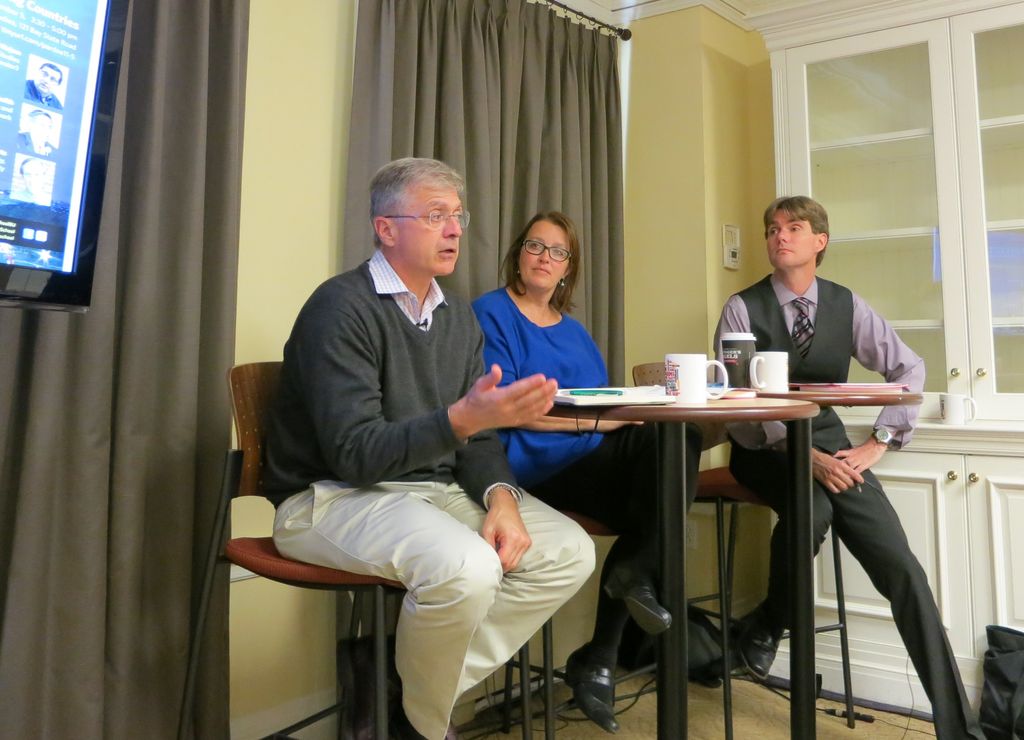Pardee Center and Pardee School Host Seminar Series on UN Climate Change Talks in Paris
The Frederick S. Pardee Center for the Study of the Longer-Range Future and The Frederick S. Pardee School of Global Studies recently co-hosted “Prospects for Paris,” a two-seminar series featuring expert panels on the upcoming UN Framework Convention on Climate Change conference to be held this December in Paris.
The first seminar, titled “The Role of the U.S., the EU, and China,” was moderated by Prof. Anthony Janetos (Pardee Center Director), and featured Prof. Henrik Selin (Pardee School of Global Studies) and Prof. Kelly Sims Gallagher (The Fletcher School, Tufts University) and was held at the Pardee Center on October 26, 2015.

The seminar focused on the world’s three largest emitters, which cumulatively account for about 45 percent of global greenhouse gas emissions. Prof. Janetos began by outlining the history of international climate change negotiations under the UN Framework Convention on Climate Change (UNFCCC), and the concept of “common but differentiated responsibilities” between developed and developing countries. He explained that the upcoming Paris conference is different than ever before because Intended Nationally Determined Contributions (INDCs) are submitted by all countries, not just developed countries. So far, 156 countries have submitted INDCs, accounting for about 90 percent of global emissions. Still, current implemented policies would lead to a global temperature rise of about 3.6 degrees C above pre-industrial levels by 2100, while implementation of all submitted INDCs would result in an increase of about 2.7 degrees C — easily exceeding the internationally stated target of 2 degrees C.
The United States’ commitment is a 26-28 percent reduction in greenhouse gas emissions below 2005 levels by 2025, which is a slightly less ambitious target than was discussed in 2010. In addition, the U.S. has a stated intention to reach a 20 percent share of non-hydro power renewables by 2030. Prof. Janetos explained that the EPA will set targets individually by states, under the legal authority of the Clean Air Act, but the implementation process remains somewhat unclear.
In Paris, Prof. Janetos believes that the INDCs, themselves, are unlikely to be major sticking points. Financing for climate adaptation measures and technology transfer for cleaner energy development, however, will likely lead to some conflict between developed and developing countries, as the promise to fund $100 billion per year in climate finance by 2020 remains out of reach.
Although the U.S., China, and the EU are the world’s three largest emitters, Prof. Selin explained that the EU is approaching the Paris talks from a very different perspective. While the United States’ and China’s emissions rose 7.7 percent and 236.7 percent, respectively, between 1990 and 2011, the EU’s emissions fell 17.6 percent during the same period. The EU’s goal is a 20 percent reduction in greenhouse gas emissions below 1990 levels by 2020, as well as goals to reach 20 percent renewable energy generation and 20 percent improved energy savings (20-20-20 by 2020), which the EU is on track to meet. Prof. Selin explained that its 40-27-27 goal by 2030, however, is not within reach given the EU’s current policies, nor is its ambitious goal to decarbonize energy systems and cut greenhouse gas emissions by 80-95 percent by 2050. Still, as the EU’s greenhouse gas emissions fell 24 percent between 1990 and 2014, the European economy grew by 46 percent, signaling a real decoupling of climate action and economic growth.

As for the outlook in Paris, the EU prefers a legally-binding agreement to INDCs, and while the EU supports the notion of “common but differentiated responsibilities” it wants strong, meaningful action by all of the major economies.
Prof. Sims Gallagher explained that China has profoundly changed its approach to climate change in the past ten years. The Chinese commitment to provide $3.1 billion in climate financing — the first commitment by a developing country — was a real breakthrough. China also has a stated goal to peak its emissions in 2030, and to achieve a 20 percent target for non-fossil fuel primary energy by 2030. Its formal INDC includes a goal to achieve a 60-65 percent reduction in carbon intensity, in addition to its recently announced national emissions trading system. While hopeful that progress will occur in Paris despite several potential roadblocks, Prof. Sims Gallagher expressed optimism because the U.S.-China bilateral agreement will create a means to continue synchronized progress between the world’s two largest emitters regardless of what happens in Paris.
Watch the full seminar above.
The second seminar, titled “The Role of Developing Countries,” was moderated by Dean Adil Najam (Pardee School of Global Studies), and featured Ali Tauqeer Sheikh (LEAD Pakistan and Climate & Development Knowledge Network) and Prof. Timmons Roberts (Environmental Studies and Sociology, Brown University). It was held at the Frederick S. Pardee School of Global Studies on November 5, 2015. For a summary of this seminar, click here.
